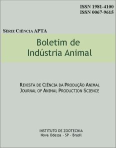Degradability of elephant grass Guaçu and Tanzania guinea grass sampled as extrusa and hand-plucked
Keywords:
degradation rate, Panicum maximum, Jacq. cv. Tanzania, Pennisetum purpureum Schum. cv. GuaçuAbstract
The trial was carried through at APTA Regional, Ribeirao Preto, SP, to compare the degradability of dry matter (DM) and neutral detergent fiber (NDF) of elephant grass Guaçu and Tanzania guinea grass sampled from extrusa and hand-plucked. The pasture management was rotational grazing. Five rumen-canulated milked cows were used for thetrial at some different times. The soluble fraction (A), the insoluble fraction potentially degradable (B), degradation rate (Kd) and the effective degradation (ED) was estimated. The statistical analysis was made considering a factorial 2x2 and split plot design (two years). There were interaction between years and grass species and sample way. The Guaçu presented higher (P<0.01) B fraction than Tanzania just for the 1st year (68.26 and 63.90% of DM) but no difference was found on the 2nd year (63.30 and 63.07% of DM). No effect of grass species was found for the other studied variables. The fraction A (% of DM), Kd(%/h) and ED5%/h (% of DM) were 14.01; 14.68; 3.21; 3.28; 40.54 and 39.05 on the 1st year and 18.01; 16.48; 2.81; 2.83; 39.34 and 39.16 on the 2nd year for the Guaçu and Tanzania, respectively. For DM, the extrusa samples presented higher results for all variables except the B fraction, for the two years. The NDF of B fraction was higher (P<0.01) for the Guaçu than Tanzania both years. No difference was found for the other variable. The extrusa presented higher B fraction and DE just or the 2nd year. The climatic conditions of the year influenced the ruminal degradation of grass species and the extrusa samples present higher in situ degradability than hand-plucked samples.
Downloads
Downloads
Published
Issue
Section
License
Os autores não serão remunerados pela publicação de trabalhos, pois devem abrir mão de seus direitos autorais em favor deste periódico. Por outro lado, os autores ficam autorizados a publicar seus artigos, simultaneamente, em repositórios da instituição de sua origem, desde que citada a fonte da publicação original seja Boletim de Indústria Animal. A revista se reserva o direito de efetuar, nos originais, alterações de ordem normativa, ortográfica e gramatical, com vistas a manter o padrão culto da língua e a credibilidade do veículo. Respeitará, no entanto, o estilo de escrever dos autores. Alterações, correções ou sugestões de ordem conceitual serão encaminhadas aos autores, quando necessário. Nesses casos, os artigos, depois de adequados, deverão ser submetidos a nova apreciação. As opiniões emitidas pelos autores dos artigos são de sua exclusiva responsabilidade. Todo o conteúdo deste periódico, exceto onde está identificado, está licenciado sob a Licença Creative Commons Attribution (CC-BY-NC). A condição BY implica que os licenciados podem copiar, distribuir, exibir e executar a obra e fazer trabalhos derivados com base em que só se dão o autor ou licenciante os créditos na forma especificada por estes. A cláusula NC significa que os licenciados podem copiar, distribuir, exibir e executar a obra e fazer trabalhos derivados com base apenas para fins não comerciais.













